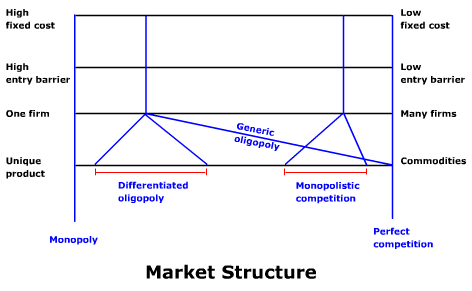Market structure depends on the uniqueness of the products, barrier to entry, and scale economy.
Since most firms produce more than one product, it is more appropriate to classify products as being sold under different market structures. The following diagram shows how products can be classified under these criteria into one of five major categories of market structures.

Market structure is a short-hand way to gauge the pricing power of the firms for a given product. Specifically, the more unique the product, the higher the entry barrier, and the larger the scale economy is, the greater the pricing power. Specifically, the many firms under perfect competition selling homogeneous products are price-takers with no pricing power. On the other hand, the monopoly firm selling patented products can exercise price discrimination. Firms in between perfect competition and monopoly are mostly single-pricing price searchers.
Even though this classification schema is conceptually clear, it is difficult to find examples that fit neatly into each category. For example, what is one product that is sold under perfect competition? Is it a commodity that is produced by many sellers? Or is it a product produced under generic oligopoly but sold by many different retailers? And if it is sold by many retailers, how can consumers without perfect information be sure that the product is priced identically by the retailers?
Similarly, some textbook authors use fast food stores as an example of monopolistic competition. Indeed, there are many hamburger stores each selling a slightly differentiated product. But these stores are part of a small number of giant fast-food chains. The parent chains, not the individual franchise stores, dictate the pricing policies. Although it does not pay for each individual store to advertise separately, advertising is a big competitive game among the fast-food chains.* So shouldn’t only mom-and-pop restaurants, such as Chinese restaurants, be classified as monopolistic competition (differentiated perfect competition)?
Market structure is an ever evolving picture. A patented product that was once sold under monopoly could over time be sold under generic oligopoly as the patent expires (See From Brands to Generics). On the other hand, a generic or differentiated oligopoly could become more concentrated through mergers and acquisitions.
- Note: (Contributed by Andrea Jacobs) Franchised fast food stores are independent owners subject to certain rules but also allowed the liberty to make business decisions specific to their needs. They pay a hefty sum for use of the brand name, and most choose to fall in line with corporate decisions.